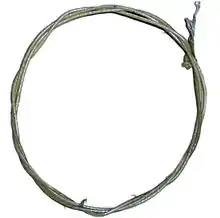Catgut
Catgut (also known as gut) is a type of cord[1] that is prepared from the natural fiber found in the walls of animal intestines.[2] Catgut makers usually use sheep or goat intestines, but occasionally use the intestines of cattle,[3] hogs, horses, mules, or donkeys.[4] Despite the name, catgut manufacturers do not use cat intestines.

Etymology
The word catgut may have been an abbreviation of the word "cattlegut". Alternatively, it may derive by folk etymology from kitgut or kitstring—the word kit, meaning fiddle, having at some point been confused with the word kit for a young cat, the word "kit" being possibly derived from Welsh.[5]
Common uses
Stringed instruments

For a long time, catgut was the most common material for the strings of harps, lutes, violins, violas, cellos, and double basses, acoustic guitars and other stringed musical instruments, as well as older marching snare drums. Most musical instruments produced today use strings with cores made of other materials, generally steel or synthetic polymer. Gut strings are the natural choice for many classical and baroque string players,[6] and gut strings are still most commonly preferred in concert-tension pedal/grand and some lever harps because they give a richer, darker sound as well as withstanding high tension within low alto, tenor, and high-bass ranges.[6] Many acoustic guitarists moved away from gut strings in the early 1900s when the C. F. Martin & Company introduced steel strings, which gave greater volume to the guitar. "The demand for steel came from ensemble players, who couldn't make themselves heard clearly without it."[7] Within a few years the majority of Martin guitars were made with steel strings to accommodate the demand. After World War II, most classical and flamenco guitarists switched from catgut to the new nylon strings for their greater smoothness, durability, and stability of intonation.
Before 1900, the best strings for musical instruments were reputedly from Italy. Musicians believed the best were from Naples, though Rome and other Italian cities also produced excellent strings. Today high quality gut strings are produced mostly in Italy, Germany, and the United States. They are also made elsewhere, for example in India and Morocco, for local use.
Sutures
Catgut suture was once a widely used material in surgical settings. Catgut sutures remain in use in developing countries where they are locally less expensive and easier to obtain. Catgut treated with chromium salts, known as chromic catgut, is also used in surgery.[8]
Tennis racquets
Natural gut is still used as a high-performance string in tennis racquets, although it had more popularity in the past and is being displaced by synthetic strings.
Production
To prepare catgut, workers clean the small intestines, free them from any fat, and steep them in water. Then they scrape off the external membrane with a blunt knife, and steep the intestines again for some time in potassium hydroxide. Then they smooth and equalize the intestines by drawing them out. Lean animals yield the toughest gut.[9] Next, they twist the prepared gut strands together to make string. String diameter is determined by the thickness of the individual guts, and by the number used. A thin string, such as a violin E, uses only three or four guts, whereas a double bass string may use twenty or more. After twisting and drying, workers polish the strings to the required diameter.
Before the twentieth century, the strings were simply rubbed with an abrasive to smooth them. Today they are generally ground down to the desired diameter using a centerless grinder. After drying and polishing, workers bleach and disinfect the strings using sulfur dioxide, dye them if necessary, and sort them into sizes.
Catgut sutures are normally treated with a chromium salt solution to resist body enzymes, to slow the absorption process, and are called catgut chromic sutures—whereas untreated catgut sutures are called catgut plain sutures.[10]
References
- Notes
- Underwood, Oscar Wilder (1913). Tariff schedules: Hearings before the Committee on ways and means. Strings for Musical Instruments. U.S. Government Printing Office. p. 5691. Retrieved February 27, 2010.
[T]here is no such thing as crude catgut or catgut unmanufactured. Catgut is a manufactured article and a finished product; the crude form are the intestines or guts of sheep or other animals.
- Roenigk, Randall K.; Henry H. Roenigk (23 January 1996). Roenigk & Roenigk's dermatologic surgery: principles and practice. p. 93. ISBN 9780824795030.
Catgut sutures are made from the submucosal layer of the small intestine of sheep and the serosal layer of the small intestine of cattle.
- "The unusual uses for animal body parts". BBC. 2011-06-06. Retrieved 2013-10-11.
- Hiskey, Daven. "Violin strings were never made out of actual cat guts". TodayIFoundOut.com. Retrieved 15 December 2015.
- Booth, Arthur Woodward (1894). "The Preparation of Surgical Catgut". Therapeutic Gazette. Retrieved 2013-10-11 – via Books.google.com.
- Bruggemeyer, Cecelia (Jan 22, 2018). "What are period instruments?". Youtube. Retrieved Jan 29, 2019.
- de Ste. Croix, Philip, editor. The Complete Guitar Encyclopedia, New York: Parragon Books, 2014, p. 14
- Start, N J; Armstrong, A M; Robson, W J (1989). "The use of chromic catgut in the primary closure of scalp wounds in children". Archives of Emergency Medicine. 6 (3): 216–219. doi:10.1136/emj.6.3.216. ISSN 0264-4924. PMC 1285609. PMID 2789586.
- "Workshop Companion". Chestofbooks.com. Retrieved 2013-10-11.
- "Types of Catgut Sutures". Dolphin Sutures. Retrieved 2014-01-07.
- Sources
 This article incorporates text from a publication now in the public domain: Chisholm, Hugh, ed. (1911). "Catgut". Encyclopædia Britannica (11th ed.). Cambridge University Press.
This article incorporates text from a publication now in the public domain: Chisholm, Hugh, ed. (1911). "Catgut". Encyclopædia Britannica (11th ed.). Cambridge University Press.
External links
| Wikimedia Commons has media related to Catgut. |